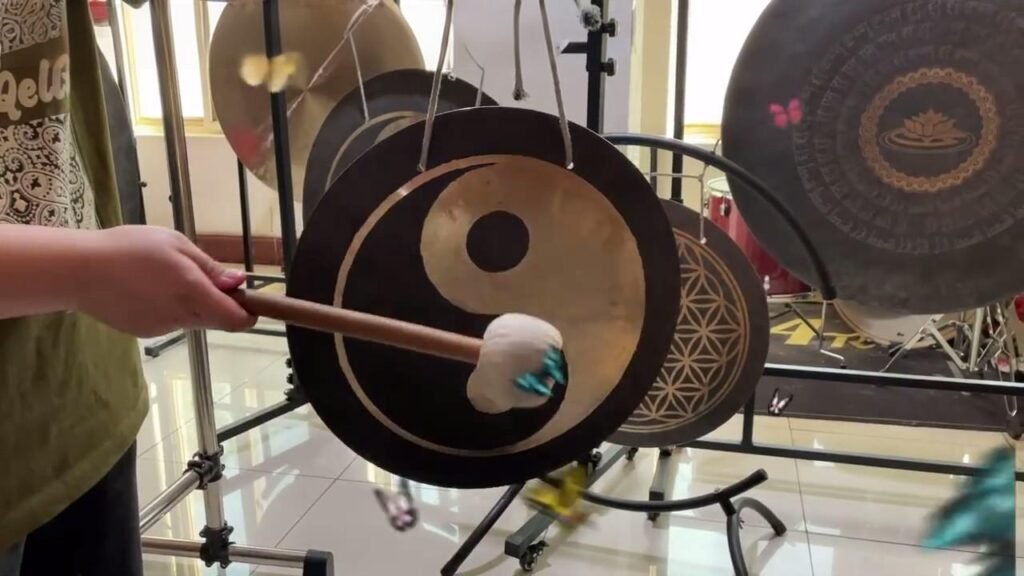In the sacred halls of monasteries across the world, the deep, resonant voice of the gong has served as more than mere timekeeper or musical accompaniment—it has functioned as a bridge between the mundane and the transcendent, a catalyst for consciousness transformation, and a unifying force in monastic communities spanning continents and centuries.
The gong’s role in monastic traditions represents one of humanity’s most enduring applications of sound for spiritual purposes, demonstrating how acoustic vibrations can serve practical, ceremonial, and contemplative functions simultaneously. From mountain monasteries of Tibet to forest temples of Southeast Asia, from Zen meditation halls in Japan to Taoist retreats in China, the gong has marked sacred time, gathered spiritual communities, and facilitated the deepest experiences of religious life.

Historical Origins and Development
Ancient Beginnings
The gong’s origins trace back to the Bronze Age, emerging from sophisticated metallurgical traditions of ancient Asia where craftspeople first discovered how to create large, resonant metal discs capable of producing sustained, penetrating tones. Archaeological evidence suggests the earliest gongs appeared in regions that would become modern-day China, Southeast Asia, and the Indonesian archipelago.
The development required mastery of multiple crafts including metal alloy formulation, precise temperature control during forging, and sophisticated understanding of acoustic principles. Ancient craftspeople discovered that specific bronze compositions, particular forging techniques, and careful attention to thickness variations could produce instruments with remarkable tonal complexity and sustaining power.
Archaeological discoveries throughout Asia have revealed gongs dating back over 3,000 years, often found in religious and ceremonial contexts that suggest their early adoption for spiritual purposes. These ancient instruments demonstrate remarkable sophistication in their acoustic design, indicating that early gong makers possessed deep understanding of how construction techniques could produce specific tonal qualities.
Religious Adoption
Shamanic traditions throughout Central and Southeast Asia were among the first to recognize the gong’s potential for facilitating altered states of consciousness and spiritual communication. These early religious applications established precedents for using gongs to mark sacred time, summon spiritual forces, and create acoustic environments conducive to transcendent experiences.
Early Buddhist communities in India and Southeast Asia adopted gongs from local cultural traditions, integrating them into monastic schedules and ceremonial practices that required reliable methods for coordinating community activities. The gong’s penetrating tone and sustained resonance made it particularly suitable for large monastic complexes where visual signals might be ineffective.
Taoist monasteries in China developed sophisticated applications that integrated acoustic timing with internal energy cultivation practices, recognizing how specific rhythmic patterns and tonal qualities could support various stages of meditation and spiritual development. Hindu temple traditions incorporated gongs into elaborate ceremonial systems that coordinated multiple aspects of worship.
Buddhist Monasteries and Gong Applications
Southern Buddhist Traditions
Sri Lankan monastic traditions developed comprehensive gong applications that integrated practical time management with spiritual practice support, using these instruments to coordinate complex schedules required for maintaining large monastic communities while supporting individual contemplative development. The gong’s clear, penetrating tone proved ideal for signaling meditation periods, meal times, work assignments, and ceremonial gatherings.
Burmese monastic traditions emphasized the gong’s role in supporting community meditation practices, developing specific striking techniques and rhythmic patterns that facilitated different stages of group contemplation. Burmese monasteries often employed multiple gongs of varying sizes and tones to create complex acoustic environments that supported both individual concentration and collective spiritual experience.
Thai monastery applications integrated gongs into elaborate ceremonial systems that served both monastic communities and surrounding lay populations, creating acoustic landmarks that oriented daily life around spiritual rhythms and sacred observances. These applications demonstrated how monastic gong use could influence broader cultural patterns while maintaining the instrument’s primary function within contemplative communities.
Northern Buddhist Developments
Chinese Chan (Zen) monasteries developed distinctive gong applications that reflected the tradition’s emphasis on sudden awakening and direct spiritual transmission, using these instruments to punctuate meditation sessions and mark moments of teaching that could trigger immediate recognition of enlightened consciousness. The gong’s capacity for producing startling acoustic events made it particularly suitable for Zen’s pedagogical methods.
Japanese Zen monasteries refined gong applications into highly precise systems that supported the rigorous training schedules characteristic of traditional Zen practice, developing specific techniques for different ceremonial contexts and meditation formats. Japanese applications often emphasized subtlety and restraint, using gongs to create moments of profound silence as much as sound.
Korean Buddhist monasteries developed unique applications that integrated Confucian organizational principles with Buddhist contemplative practices, using gongs to maintain hierarchical structures and ceremonial protocols that supported intensive meditation training while reinforcing social harmony.
Tibetan Buddhist Traditions
Tibetan monastic communities developed perhaps the most elaborate gong applications in Buddhist tradition, integrating these instruments into complex ceremonial systems that could involve dozens of different acoustic elements coordinated to create transformative spiritual experiences. Tibetan applications often emphasized the gong’s capacity to facilitate consciousness alterations necessary for advanced tantric practices.
The use of gongs in Tibetan monasteries often involves specific timing relationships with other instruments including bells, horns, and drums that create intricate acoustic mandalas designed to support different stages of ritual practice and meditation development. These complex orchestrations require years of training to master and represent sophisticated understanding of how acoustic environments can influence consciousness states.
Tibetan applications also emphasize the gong’s protective functions, using specific striking techniques and ritual contexts to invoke spiritual guardians and establish energetic boundaries around sacred spaces and practices. Modern Tibetan Buddhist communities in exile have adapted traditional gong applications to contemporary contexts while preserving essential spiritual functions.
Taoist and Traditional Chinese Monasteries
Taoist Monastic Applications
Taoist monasteries developed unique gong applications that reflected the tradition’s emphasis on natural harmony and energetic cultivation, using these instruments to support practices designed to align human consciousness with cosmic rhythms and natural cycles. Taoist applications often emphasized subtle timing relationships that coordinated external acoustic events with internal energy circulation patterns.
Wudang Mountain Taoist communities integrated gongs into martial arts training and internal energy cultivation practices, recognizing how specific acoustic patterns could support the development of internal power and consciousness refinement necessary for advanced spiritual achievement. These applications demonstrated practical understanding of how external stimuli could influence internal energetic processes.
Taoist alchemy traditions used gongs to mark different stages of internal transformation practices, creating acoustic frameworks that supported the complex visualization and energy circulation techniques characteristic of internal alchemy training. These applications required precise timing and technique to coordinate with the subtle internal processes being cultivated.
Folk Religious Applications
Chinese folk religious traditions incorporated gongs into community temple practices that served both spiritual and social functions, using these instruments to coordinate seasonal celebrations, life transition ceremonies, and community protection rituals. These applications demonstrated how monastic-developed techniques could serve broader cultural needs while maintaining their spiritual effectiveness.
Confucian temple traditions used gongs in educational and ceremonial contexts that emphasized social harmony and cultural transmission, recognizing how acoustic signals could support disciplined study and moral cultivation considered essential for social leadership. Local deity temples throughout China developed distinctive gong applications that reflected regional cultural characteristics while maintaining connections to broader religious traditions.
Other Religious Traditions
Hindu Temple Traditions
Hindu temple complexes developed sophisticated gong applications that integrated these instruments into elaborate worship systems designed to create comprehensive sensory experiences that facilitated divine communion and spiritual transformation. Different Hindu traditions developed specific gong techniques associated with particular deities and spiritual practices.
Temple festival traditions throughout India incorporated gongs into community celebrations that brought together spiritual practice, cultural expression, and social cohesion, using these instruments to coordinate large-scale religious activities while maintaining their contemplative and devotional functions.
Sikh and Jain Applications
Sikh gurdwaras developed distinctive gong applications that reflected the tradition’s emphasis on community service and egalitarian spiritual practice, using these instruments to coordinate congregational activities and support collective worship. The integration of gongs into Sikh community service activities demonstrated how spiritual instruments could support practical charitable work.
Jain monastic communities developed unique gong applications that reflected the tradition’s emphasis on non-violence and consciousness purification, using these instruments to support meditation practices designed to minimize harm while maximizing spiritual development. These applications often emphasized subtle acoustic approaches that avoided disturbing other forms of life.
The Role of Gongs in Meditation and Spiritual Practice
Consciousness State Transformation
The gong’s capacity to facilitate altered states of consciousness represents one of its most significant contributions to monastic spiritual practice. Communities across traditions recognize how specific acoustic experiences can trigger transitions between ordinary awareness and contemplative consciousness states, often involving careful attention to timing, technique, and acoustic environment.
Attention focusing represents a fundamental application of gongs in contemplative practice, with the instrument’s penetrating tone and complex harmonic structure providing ideal objects for concentration development and mental stabilization. The gong’s capacity to induce profound experiences of timelessness and spatial expansion has made it particularly valuable for supporting advanced contemplative practices.
Many monastic traditions recognize the gong’s ability to facilitate experiences of unity consciousness and ego dissolution that represent significant milestones in spiritual development, using these instruments to support practices designed to realize the illusory nature of separate selfhood and access direct recognition of fundamental reality.
Energy Harmonization Functions
Traditional understanding of the gong’s energetic effects emphasizes its capacity to balance and harmonize subtle energy systems within individuals and communities, with many monastic applications specifically designed to optimize energetic conditions for spiritual practice and consciousness development.
Chakra activation and balancing represents a significant application of gongs in many Eastern monastic traditions, with specific techniques developed for influencing different energy centers and facilitating the free flow of vital energy throughout the practitioner’s system. Environmental energy clearing has become an important function, with communities recognizing how these instruments can purify spaces and remove energetic accumulations.
Collective energy synchronization represents another significant application, with gongs used to align group energy and create unified fields that support collective spiritual practice and community coherence, demonstrating understanding of how acoustic tools can influence group consciousness.
Psychological and Emotional Healing
Stress release and nervous system regulation represent important therapeutic applications of gongs in monastic contexts, with many communities recognizing how specific acoustic experiences can facilitate deep relaxation and restore psychological balance necessary for sustained spiritual practice.
Emotional regulation and trauma healing have become increasingly recognized applications, with understanding growing about how specific acoustic experiences can help process and integrate difficult emotions while maintaining psychological stability necessary for spiritual development. The gong’s capacity to stimulate creativity and problem-solving abilities has made it valuable for supporting intellectual and artistic activities that complement contemplative practice.
Modern Monastic Applications
Integration of Traditional and Contemporary Approaches
Contemporary monastic communities have developed innovative approaches to gong use that preserve traditional spiritual functions while adapting to modern circumstances including urban environments, multicultural communities, and technological integration. These adaptations often involve simplifying complex traditional applications while maintaining their essential spiritual effectiveness.
The integration of recording technology and sound systems has allowed monastic communities to preserve and share traditional gong applications while making them accessible to broader audiences. International and intercultural monastic communities have developed approaches that honor diverse traditional backgrounds while creating unified practices that serve community cohesion.
Educational and Social Functions
Novice training programs in contemporary monasteries often use gongs to teach fundamental principles of contemplative practice including attention development, emotional regulation, and spiritual community participation. Lay practitioner education has become an important function, with communities developing programs that share traditional techniques with non-monastic students.
Academic research collaboration has allowed monastic communities to contribute to scientific understanding of consciousness and meditation while maintaining spiritual integrity. Therapeutic applications in healthcare settings have allowed communities to share gong benefits with broader populations while maintaining their spiritual orientation.
Acoustic Properties and Spiritual Effects
Physical and Neurological Characteristics
The gong’s unique acoustic signature results from its construction and playing techniques, producing complex harmonic structures that create rich, sustained tones with multiple frequency components. Contemporary neuroscience research has begun documenting specific brain state changes associated with gong exposure, revealing patterns that correlate with traditional descriptions of consciousness alterations.
Brainwave entrainment effects demonstrate how gong exposure can influence neural oscillations in ways that promote meditative states and enhanced psychological integration. Autonomic nervous system regulation through gong exposure often produces measurable changes in heart rate variability and stress hormone levels that indicate deep relaxation.
Spiritual and Psychological Impacts
Consciousness state alterations facilitated by gong exposure often include experiences of expanded awareness, ego dissolution, and direct spiritual insight that traditional contemplative literature describes as significant milestones in spiritual development. Emotional regulation and psychological healing through gong exposure often involves release of stored trauma and development of enhanced emotional intelligence.
Social bonding and community cohesion often increase through shared gong experiences that create feelings of unity and mutual understanding among participants, supporting the community harmony essential for successful monastic life. Spiritual insight and wisdom development facilitated by gong exposure often includes direct recognition of fundamental spiritual truths.
Conclusion
The enduring presence of gongs in monastic traditions across cultures and centuries testifies to their fundamental importance as tools for spiritual development and community organization. From the earliest Buddhist monasteries to contemporary contemplative communities, these remarkable instruments have served functions that extend far beyond simple timekeeping to encompass consciousness transformation, community unity, and direct spiritual awakening.
The diversity of gong applications across different monastic traditions demonstrates both the instrument’s remarkable versatility and the universal human recognition of sound’s power to facilitate spiritual experience. Understanding the gong’s place in monastic life reveals important insights about the relationship between external acoustic stimuli and internal spiritual development, showing how carefully applied sound can support the consciousness transformations that represent the ultimate goal of monastic practice.
For contemporary spiritual seekers, the monastic use of gongs offers valuable models for integrating acoustic tools into personal practice while maintaining connection to wisdom traditions that have proven their effectiveness across generations. The echoes of enlightenment that resonate through centuries of monastic gong use continue to offer guidance and inspiration for contemporary practitioners seeking authentic spiritual development and community harmony.
Through understanding and honoring the gong’s role in monastic traditions, contemporary practitioners can access time-tested methods for spiritual development while contributing to the ongoing evolution of contemplative practice that serves both individual awakening and collective wisdom. The ancient echoes continue to reverberate, calling each generation to discover anew the transformative power of sacred sound in service of human spiritual potential.







